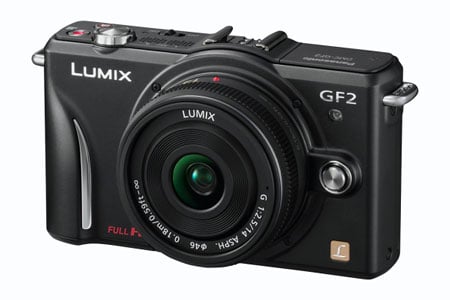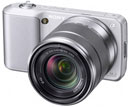Panasonic Lumix DMC-GF2
-
-
Written by Gordon Laing
Verdict
The Lumix DMC-GF2 is Panasonic’s second ‘pocketable’ compact to employ the Micro Four Thirds standard it co-developed with Olympus. Announced in November 2010, it’s the successor to the popular Lumix GF1, and like that model packs a large sensor into a small body with a removeable lens mount.
The most obvious difference between the Lumix GF2 and its predecessor is size: the new model is 19% smaller and 7% lighter, making it the smallest camera with interchangeable lenses and a built-in flash. Couple it with the new Lumix G 14mm pancake prime lens (pictured below) and you’ll have a seriously compact system.
Round the back, the GF2’s new touch-screen delivers some neat functionality such as being able to tap the subject you’d like the camera to focus on (or track), while the upgraded movie mode features 1080i video with long recording times. It’s not all good news though, as the image quality from in-camera JPEGs or even converted RAW files falls below its key rivals, and while the touch-screen is nice, many would find the built-in stabilisation of the Olympus E-PL2, or the bigger sensor and innovative composite modes of the Sony NEX more useful. So how does the Lumix GF2 measure-up against these key rivals in other respects, and ultimately which mirror-less EVIL camera will be best for you? Find out below…
 |
Compared to Olympus ‘PEN E-PL2
The Panasonic Lumix GF2 and Olympus E-PL2 have a lot in common. Both are based on the Micro Four Thirds standard jointly developed by the two companies, they share the same sensor size and lens mount and have the same size and resolution screens, though the Lumix GF2’s is touch-sensitive.
So what sets them apart? In terms of handling, the Lumix GF2 body is significantly smaller than the E-PL2 and has fewer external controls with shooting mode and other settings devolved to the touch-screen. With 1080i HD video and a choice of either AVCHD or Motion JPEG encoding, the Lumix is a better option for video. It also has built-in stereo mics compared to the E-PL2’s mono mic, though the latter can be equipped with the optional SEMA-1 external mic adapter. Indeed the accessory port on the GF2 is pretty much limited to the optional EVF right now, whereas Olympus offers a variety of options for its port.
Probably the most significant difference, though, is that the E-PL2 employs sensor-shift image stabilisation in the body that works with any lens you attach. Unless you have a stabilised lens attached to the GF2, like the 14-42mm f3.5-5.6 Mega O.I.S kit zoom we tested it with, you’ll need to boost the ISO sensitivity by two or three stops to get similar low-light exposure settings. Paradoxically, this means you can fit the desirable new Lumix 14mm f2.5 pancake prime to the E-PL2 and take advantage of image stabilisation that’s absent on the Lumix GF2.
It’s also worth noting the weight advantage of the GF2 is eliminated once you fit the respective kit zooms on it and the E-PL2, with both subsequently sharing similar operational weights. The E-PL2’s new kit lens also collapses when not in use to save space. In our tests the E-PL2 additionally enjoyed superior image quality.
Like their predecessors, it’s a tough-one to weigh-up, but the built-in stabilisation, more flexible accessory port and superior image quality (both out of the camera and from processed RAW files) gives the E-PL2 a number of key advantages over the GF2 for many photographers. At the time of writing it was also a little cheaper too. See our Olympus E-PL2 review for full details.
Compared to Sony Alpha NEX-3 / NEX-5
With a larger, higher resolution sensor, higher resolution articulated screen and extremely compact proportions, the NEX models look like a very attractive alternative not just to the Lumix GF2 and Olympus E-PL2, but to Micro Four Thirds system cameras in general. This is particularly true of the NEX-3 which is priced very competitively. The NEX models also offer exceptionally good low light performance as well as exposure modes that automatically composite multiple images to produce excellent results. They additionally boast very fast continuous shooting capabilities.
So what’s not to like about the NEX models? They don’t have the range of lenses available to the Micro Four Thirds system, but that will change in time and meanwhile there are third party adapters that will let you attach other lenses. Like the Lumix GF2, the NEX models rely on lens-based image stabilisation. They also lack a built in flash or hotshoe, though a small flash unit is included in the box which attaches to the accessory port.
Then there’s the question of handling. Though firmware updates have added, among other things, revised menus, button customisation options, better manual focussing control, and aperture control in movie mode, the NEX menu system and software remains better suited to point-and-shoot operation than advanced manual control. If you’re thinking of buying a mirrorless compact as an SLR alternative and plan to do a lot of manual shooting, you’ll probably find the Lumix GF2 a better fit.
But again it’s hard to resist the appeal of a bigger sensor in a smaller body with a tilting screen, fast shooting and cunning composite modes. If you can accept some handling and user interface issues the NEX-3 and NEX-5 are tought to beat. See our Sony Alpha NEX-3 / NEX-5 review for full details.
Panasonic Lumix GF2 final verdict
In removing many of the GF1’s physical controls and replacing them with a touch screen, Pansonic has widened the appeal of the GF2 to those looking to trade up from an advanced compact. The risk, of course, was that it would alienate enthusiasts who, above all, want the same kind of control and handling as provided by a DSLR. It has skillfully managed to avoid that trap by retaining the crucial physical controls, namely the rear thumbwheel and control pad and making the most of the touch-screen interface to produce a camera that is a joy to use, whether in point-and shoot iA and screen modes, or using fully manual exposure and focussing.
As far as the touch screen goes, it a great first effort, but Panasonic could do a lot more with it. God forbid it should dispense with physical buttons for exposure control, but there are many situations where the duplication of touch and physical controls to achieve the same end result leads to confusion and if these were resolved the overall handling would be even better.
Lastly there’s the question of image quality and noise performance. The GF2’s sensor and image processing can’t manage to produce results on a par with its biggest competitors, the Olympus E-PL2 with its excellent JPEG engine, or the Sony NEX-3/5 with it’s larger sensor and clever composite modes.
Ultimately though the Lumix GF2 is a desirable and welcome new addition to Micro Four Thirds camp and one that will undoubtedly find favour with enthusiasts and ambitious novice photographers alike. It’s a lovely camera to use and one that’s also physically very desirable, but the issues discussed on this page – or perhaps more fairly, the benefits of its rivals – means it just falls short of our top rating in direct comparison. It still earns a hearty Recommended though.
Bad points | Scores (relative to 2011 EVIL cameras) |
 | ||
Build quality: Image quality: Handling: Specification: Value:
Overall: |
18 / 20 15 / 20 18 / 20 16 / 20 15 / 20
82% | |||






